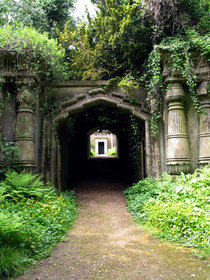Highgate Cemetery
|
|
Highgate Cemetery is a famous cemetery located in Highgate, London, England.
The cemetery in its original form (the older, Western part) was opened in 1839, part of an initiative to provide seven large, modern cemeteries (known as the "Magnificent Seven") in a ring round the outside of London. The inner-city cemeteries, mostly the graveyards attached to individual churches, had long been unable to cope with the number of burials and were seen as a hazard to health and an undignified way to treat the dead.
Highgate, like the others, soon became a fashionable place for burials and was much admired and visited. The Victorian attitude to death and its presentation led to the creation of a wealth of Gothic tombs and buildings. It occupies a spectacular south-facing hillside site slightly downhill from the top of the hill of Highgate itself, next to Waterlow Park, both of which were part of the former Dartmouth Park which covered the area.
In 1854 the area to the east of the original area across Swains Lane was purchased to form the eastern part of the cemetery. This part is still used today for burials.
The cemetery's grounds are full of old-growth trees, shrubbery and wildflowers that are a haven for birds and small animals like hedgehogs. The Egyptian Avenue and the Circle of Lebanon (topped by a huge Cedar of Lebanon) feature tombs, vaults and winding paths dug into hillsides. For its protection, the oldest section, which holds an impressive collection of Victorian mausoleums and gravestones, plus elaborately carved tombs, allows admission only in tour groups. The newer section, which contains most of the angel statuary, can be toured unescorted.
Although its most famous occupant in the east cemetery is probably Karl Marx (whose tomb's most recent bombing is still recalled by some Highgate residents), there are several prominent Victorians buried here. Interments include:
- Douglas Adams - (Author)
- Edward Hodges Baily - (Sculptor)
- Rowland Hill - (Inventor of postage stamps)
- John Singleton Copley - (Artist)
- George Eliot (Mary Ann Evans) - (Novelist)
- Michael Faraday - (Scientist)
- William Friese-Greene - (Inventor of cinematography)
- Radclyffe Hall - (Author of The Well of Loneliness and other novels)
- Karl Heinrich Marx - (Father of Marxist philosophy, the basis of Communism.)
- Henry Moore, (1841-1893) - (Marine painter)
- Michael Redgrave - (Actor)
- Ralph Richardson - (Actor)
- Elizabeth Siddall - (Wife and model of artist/poet Dante Gabriel Rossetti)
- Sir Donald Alexander Smith - (Canadian railway financier and diplomat)
- Herbert Spencer - (Social Darwinism)
- Arthur Waley - translator and oriental scholar
The nearest transport link to the cemetery is Archway.
Additionally, the Highgate Cemetery is well known for its occult past, being the site of the controversial Highgate Vampire (as written by Bishop Sean Manchester.)
See also
External link
- Friends of Highgate Cemetery (http://highgate-cemetery.org/)
- Biographical tour of Highgate Cemetery (http://www.tales.ndirect.co.uk/SEXTON_TALE.HTML)
- Vampire Research Society (http://www.gothicpress.freeserve.co.uk/Vampire%20Research%20Society.htm)


